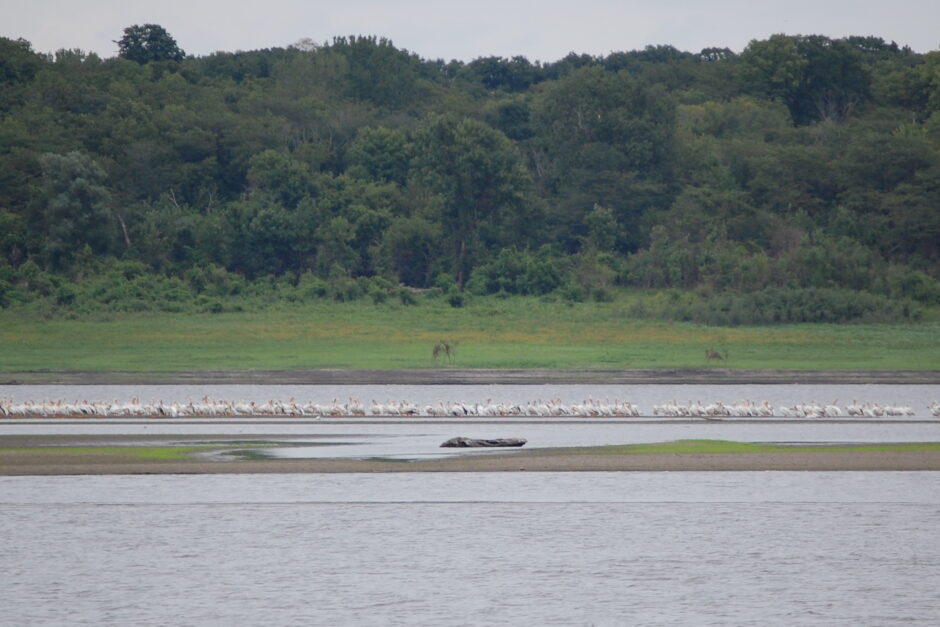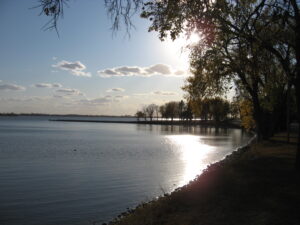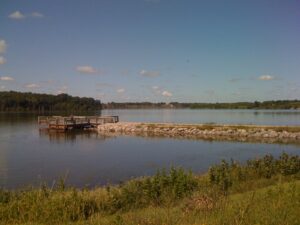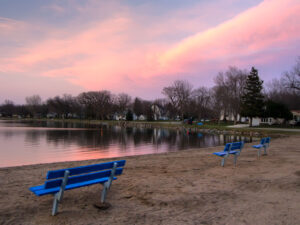Improving Iowa Lake Conditions with Restoration Program
 Pelicans during the Pelican Festival at Saylorville Lake in central Iowa. (Credit: Rastoney via Flickr CC BY-NC 2.0)
Pelicans during the Pelican Festival at Saylorville Lake in central Iowa. (Credit: Rastoney via Flickr CC BY-NC 2.0)Iowans are well-known for their vast cornfields and farmlands, but they also dedicate a considerable chunk of time to their lakes. Surveys by Iowa State University discovered that 65% of Iowans visit a lake several times a year, generating over $1 billion from recreational activity annually.
“Sixty percent—that’s a super majority of people—visit a lake each year,” said Mike McGhee, the restoration program manager for the Iowa Department of Natural Resources (DNR) Fisheries Bureau.
The popularity of the lakes made Iowa’s Lake Restoration Program (LRP) an easy sell to the state legislatures, who have provided over $147 million for LRP projects since 2007. Created to make Iowa’s lakes cleaner and safer, the LRP modeled its approach off of the federal Clean Lakes Program.
Before any LRP projects began, the Iowa DNR assessed 127 lakes in Iowa. Of those, 35 lakes and 5 shallow lakes were listed as priority lakes for restoration. So far, in the LRP’s seventeen-year history, 35 lake restorations have been completed and are being maintained, 20 lakes are being actively restored, and 15 lakes are in the initial planning process. Iowa’s DNR provides an online status map for all Iowans to check the yearly status of the lake restorations.
If a county wants its lake to be considered for restoration, the state must have the local community’s support and the lake must be tested by a science team. The science teams, usually hired from Iowa State University, conduct multiple studies to decide if the lake restoration can be done, how it can be done, and how much it would cost.
The results will then be used to prioritize the lakes and rank them on restoration potential, gauge community support, and identify potential partners to help with expenses.

Storm Lake, Iowa (Credit: Denise Krebs via Flickr CC BY 2.0)
Lake Monitoring and Restoration Plans
In 2000, Iowa’s DNR invested in a Lake Monitoring Program (LMP) that monitors chemical, physical, and biological properties in 140 lakes. The data the LMP collects is shared on an online database and used by the LRP to assist in creating the lake priority list and evaluating restoration success rates.
Since the LRP’s inception, it has partnered with the LMP to determine how water quality impacts how much Iowans visit lakes. Currently, the LRP funds 40% of lake monitoring efforts across the state, hoping to improve lake conditions for Iowans.
According to the LRP’s annual report, lakes are primarily assessed for water quality, sedimentation rates, and phosphorus levels. Higher-priority lakes experience harmful algal blooms (HABs) as well as greater sediment loads and nutrient pollution.
Before beginning restorations, the LRP preemptively funds initiatives to reduce the sediment and nutrient flow from the agricultural watersheds, improving water clarity. Reducing agriculture outputs into waterways allows the LRP to focus on removing excess sediment and nutrients within the lakes during restoration.
According to McGhee, Iowa is a big agricultural state, being one of the top producers of various produce like corn, soy, and hogs. Because of the reliance on agriculture, McGhee adds that Iowa is “Probably one of the most altered environments in the United States.”
Keeping Iowa’s water clean is essential recreationally, so all water restoration must meet the LRP’s water quality standards: clarity, safety, quality, sustainability, and biota health. Each variable must be maintainable for the restoration to be considered successful.
The LMP emphasizes that implementing successful water quality restoration relies on understanding and managing phosphorus levels. Although phosphorus is a vital nutrient for the lake’s biota, excessive amounts are harmful.

Lake Sugema, Iowa (Credit: Steven Garner via Flickr CC BY 2.0)
The LRP aims to control phosphorus delivery from watersheds before restoration, making it easier to treat already present phosphorus levels in the lake. While considerable amounts of phosphorus come from watersheds, the internally recycled phosphorus within lakes contributes to the frequency and severity of HABs and water quality problems, including poor water clarity.
One method Iowa’s DNR has tested to improve water quality and phosphorus levels is adding aluminum sulfate (alum), which clears surplus phosphorus from a lake’s water column.
Phosphorus levels are also significantly increasing in shallow lakes and wetlands, leading the state’s DNR to dedicate additional improvements to them, such as water control structures and pumps for draining.
Although upgrades have been effective, the Iowa drought–which improved early this May–led to declining numbers of shallow lakes and wetlands, which drives the DNR to continue improving those that survived the drought.
Finished and Current Restoration Projects
As one of Iowa’s natural lakes, Black Hawk Lake is a popular spot for Iowans and anglers alike. When the lake was added to the original 35 prioritized lakes list, its water was of poor quality and low clarity.
Black Hawk Lake’s restoration began in 2009 with watershed improvement efforts, adding 215 best practices through local partnerships and implementing best practices throughout the watershed to reduce sediment and phosphorus pollution by 68%.
The Iowa DNR also renovated the fishery, restocked sport fish species, and stabilized the shoreline. For long-term sustainability, they created 3 fish barriers to stop migrating carp due to their tendency to disturb bottom sediment and negatively affect the water quality.

Five Island Lake, Iowa (Credit: David Morris via Wikimedia Commons CC BY 2.0)
Completing the restoration in 2023, they removed extensive sediment from the bottom of the lake with a major dredging project. The restoration has improved recreational opportunities for the lake’s community and cost $18.5 million, with the LRP investing $9.8 million.
A popular spot for sport fishing and family entertainment, Volga Lake is one of the LRP’s most recent restoration projects. A 2015 survey indicated that the lake suffers from high algae levels, finding high volumes of phosphorus and sediment pollution entering from its watershed. After investigating the park’s gullies, they found various areas of erosion that contributed to the pollution.
Project partners and the LRP began planning official restoration to stabilize the erosion in 2018. They designed and built several rock check dams and terraces to slow the water and prevent further erosion. The structures also serve as additional wetlands for the lake’s habitat.
After finishing the initial project in 2020, they removed several small trees for additional erosion control and to boost vegetation growth. Later this year, a second round of structures will be implemented to address the remaining erosion points. So far, the small-scale project has cost roughly $64 thousand.
Conclusion
Along with funding and research, community support is essential for the LRP’s restoration success. It could be difficult for the LRP to talk to communities about how their lake is realistically functioning because it’s personal to them. However, the group must also set reasonable expectations for restoration work. While the LRP can improve the lakes they work with, not every lake can be the best in the state.
Lake restoration efforts are improving with every project the LRP accomplishes. Clean and sustainable lakes will provide Iowa with long-term recreational use and economic profit. Ultimately, the LRP is gradually achieving the Iowa DNR’s goal of providing healthy and safe lakes for their communities.

Clear Lake, Iowa (Credit: Tim Fuller via Flickr CC BY 2.0)



0 comments